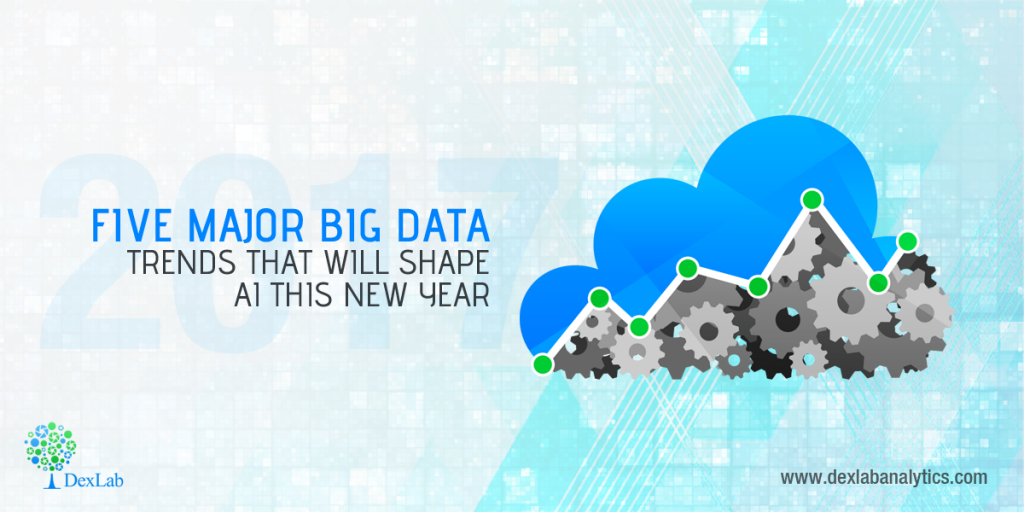Many still believe that Big Data is a grossly misunderstood, mega trending buzzword in the tech field even today. However, there is still no denying of the fact that the recent development of AI and machine learning push is related on the synthesis and labelling of huge amounts of training data. A latest trend report by the advisory firm Ovum predicted that the Big Data market which currently is valued to be USD 1.7 billion, will further rise to be USD 9.4 billion by 2020.
Then what do the insiders in the data analytics market see it happening in the upcoming year ahead? We at DexLab Analytics, the premiere Big Data Hadoop institute in Delhi spoke to several leaders in this field to discover.
Here is what we found to be the five most important trends that will shape the future of machine learning, AI and data analytics in 2017 from the industry experts:
The predictions strongly emphasize the need for more talent and skilled personnel in this vast field of data analytics, thus, a growing demand for Big Data training and Big Data courses will be witnessed worldwide.
Due to the development of AI and machine learning the need for data analytics will rise:
It is a no brainer that data analytics and labelling is a major driving force for AI. Carla Gentry a data scientist from Louisville, KY stated, “Machine learning has really come a long way, and 2017 will be the year we see more expertise but despite that it will struggle with the proper understanding, execution and talent.”
“IoT will also surge with toys, car accessories, home and security use but it will also set up pace for the unscrupulous hackers with increased access to private lives”, she further added.
“The growing problems are constantly being abetted by the machine learning, which lowers the obstacles to the adoption of big data enabled analytics and solutions. Such was the comment shared by Baer, he further said, “the growing dominance of the cloud that will further ease the hurdles to deployment”.
In such circumstances, it is understandable that allied courses relevant to the field of Big Data, such as the visualization training of Big Data Hadoop courses.
Self-servicing data tools will hit the market and take the web by storm:
With the developments in data processing and cloud applications, there is an array of free data platforms available on the internet that can allow organizing and synthesizing data easy, this will also be easier for the beginners.
Almost every platform these days is becoming cloud available, and Big Data platforms like Splice Machine are now emerging as self-service platforms. All you need to do is specify the amount of storage and the compute what you need in terms of databases that appear in the cloud for both the apps requirement as well as the need for data warehouses, which will be done within minutes.
Analytics sector is still having problems keeping up the pace:
Despite all the great tools and data warehousing systems, the field of analytics remain complicated. While there are giant data warehousing systems now available on Big Data like Spark and Hadoop, corporations are still facing issues to transfer data from the operational systems, this gap needs to enable seamless combination of both the work pipelines.
This should be the preparatory war cry for those young and ambitious aspiring, Big data personnel to take up a Big Data Hadoop training in Delhi.
With more availability of data, and algorithms, more automation will be possible along with better feasibility for predictions. So, this is the time to acquire a proper Hadoop certification in Delhi.
Data cleansing will become an industry in itself:
To get training data into the systems for machine learning they must be cleansed, this suggests that we must make sure the information within the database has been thoroughly checked for errors in the formatting, duplication or something else.
Data needs democratization:
The idea proposed by Jim Adler, head of data at the Toyota Research Institute, of data not living in lakes has made several headlines previously. However, it does live in silos where the accountability, focus and mission is clear as stated by Adler.
Thus, for server-less, micro service architectures it is becoming gradually simple for such silo owners to access, analyze and manage their data without racking the servers, or needing machine configuration with virtual device and being a cost effective way of not needing to be paid by the hour. Being server less allows the owners of data to concentrate on their data application and pay just what they use by the minute.
Also see
How To Stop Big Data Projects From Failing? (Dexlab Analytics)
Big Data Analytics and its Impact on Manufacturing Sector (Dexlab Analytics)
Big Data Hacks: 5 Amazing Free Data Sources (Dexlab Analytics)
Big Data Analytics Is Helping To Curb Cancer For More Than 40 Years Now (Dexlab Analytics)
Big Data, Big Data Analytics, Big data certification, Big data certification pune, Big data courses, big data hadoop, Big data training, online certification, online courses

Comments are closed here.